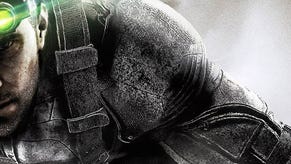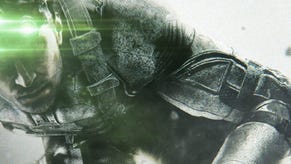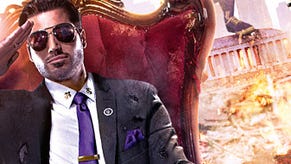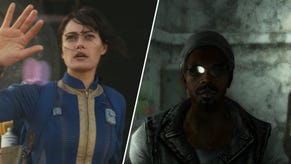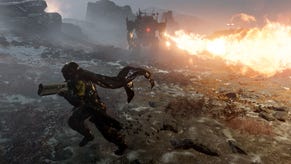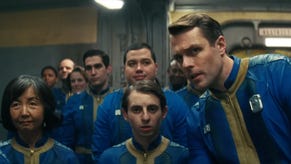Splinter Cell Blacklist: the myth of redemptive violence
After a tumultuous few months for Sam Fisher’s latest outing, Stace Harman speaks to Ubisoft Toronto to find out if underneath all the headline violence is a story worth telling.
We’ve seen it play out 100 times before: there is a man, he’s kicking arse and chewing gum; he’s probably wearing a leather jacket. He storms a building; he cripples, maims and shoots-between-the-eyes half a dozen scowling, thick-set security guards whose broken bodies fall to the floor at awkward, unnatural angles. He pushes through the pain of a bullet lodged in his shoulder to face off against an antagonist with a mild physical deformity who, after an extended fight scene, is left facing inevitable death. After muttering a few choice words through gritted teeth, the wounded warrior delivers the coup de grace and brings to an end the whirlwind of ratified violence.
The screen faces to black, order has been restored to the universe, savage justice has been meted out and the bad guys have gotten what they so richly deserved.
“When you look at [Splinter Cell] Conviction, that was very much a revenge story,” says Ubisoft Toronto’s cinematic director, David Footman.
“Someone’s taken [Fisher’s] daughter, so we have this very Liam-Neeson-Taken idea. It’s a great action convention that works because it allows people to identify with it and enables a certain level of justification because the central character can kill anyone to get his daughter back and the audience will cheer. I think of it as the myth of redemptive violence; it’s a story telling device.”
The merits of this story-telling device are debatable: its lack of concern for morality along with its clean-cut delivery ensures that no difficult questions are asked of the audience and it can rarely be taken on anything other than face value, but it does provide an uncomplicated and relatable narrative focus. This is perhaps why Ubisoft Toronto appears to be taking this tried and tested plot device and applying it, on a larger scale, to its first entry in the series: Splinter Cell Blacklist.
Dabbling in the potentially messy world of geopolitics, the titular Blacklist applies a time-driven narrative arc in which the US government is issued with a list of high profile targets by the story’s antagonists. The “baddies” in this instance are a hotchpotch of North America’s enemies brought together in what Footman describes as “...what would happen if all the countries in the world that had a bone to pick with America, banded together and crowd-sourced.”
This leads to an enemy of many faces that is dispersed across many fronts, requiring Cell-hero Sam Fisher to trot across the globe, chewing gum, kicking arse and amassing a glut of air miles as he races to eliminate those behind the attacks before they can complete their macabre To Do list.
Although the notion of the enemy providing a list of targets in advance seems quite civilised, the level of the threat and severity of the attacks is such that the President of the US has granted Fisher the “fifth freedom” in order to achieve his objectives. This is succinctly summed up as “the right to defend our laws by breaking them,” and effectively renders Fisher a law unto himself, neither answerable nor beholden to anyone.
In theory, limitless freedom is meant to sound edgy and extreme, but so far it has appeared as little more than an illusion; another plot device that is used to justify Fisher’s option to be much more gung-ho approach in achieving his objectives. More interesting is Footman’s suggestion that the effects that this supposed freedom might have on an individual could be explored in more detail.
“No one can be immune to the amount of violence that comes from these situations,” states Footman. So, when you’re wrapping a story around a game that’s about killing hostiles, it’s a huge focus for us to examine that.
“For me, it’s particularly interesting to look at the effect of covert actions, like a vehicle driving down the road that gets taken out by a drone strike: there’s no court and no jury. That’s the new war on terror: going out and taking the war to the enemy. Now, whether you’re the pilot that shot that missile or whether you’re the guy on the ground like Sam Fisher, you can’t be immune to the violence and it’s an interesting concept for us to explore.”
It’s difficult to tell how deep Ubisoft will go in exploring this concept. So far, the marketing of Splinter Cell Blacklist has been geared very much towards the notion that route-one is by far the most attractive and effective, while Fisher’s new-found fistful of freedom has resulted in ludicrous levels of violence (see the “Fifth Freedom” trailer for the greatest, single example of an overreaction to someone asking to speak to the manager). If Fisher is indeed struggling to establish boundaries for himself, we’re yet to see a glimpse of what ill effects may come of it.
Fisher’s courting of a wider, action-orientated audience has also resulted in there being little evidence that he has a subtle bone left in his body. Despite this, Footman assures us that the brand will honour its past.
“There are really two different styles of play, you can ghost or you can be more action-orientated ... There’s a massive amount of energy being put into level-design to handle both kinds of game play and [stealth] is a huge pillar for the brand.
When you market a game, the Michael Bay explosions tend to get viewed more and they tend to get shown more. But this is a monster game, it’s deep and it’s rich, so there’s definitely going to be a huge stealth component to every single map and some maps are built so that you have to go in that way.”
Undoubtedly, there is a time, place and sizeable audience for those Michael Bay explosions. Over the coming months it’s going to be up to Ubisoft Toronto to convince us that Splinter Cell Blacklist can accommodate both the overblown and the understated and show that Fisher has not lost the power of restraint and surprise. The last thing we need is yet another variation of that generic and predicable opening scene, for we all know how that story ends.






